Panel 1
Stefano Mariani
The 12-month Standardized Precipitation Index (SPI) maps provide a nationwide and large-scale assessment of hydrological drought conditions, obtained using precipitation data collected and published by regional hydro-meteorological services and autonomous provinces and those of the suppressed National Hydrograph and Tire Service (SIMN, now merged into ISPRA) of the Department for National Technical Services. The 12-month aggregation timepiece chosen for the SPI assessment is the one that best describes the effects of drought (precipitation deficit) on the flow rate of rivers, recharging reservoirs and water availability in the aquifers.
In 2024, the 12-month SPI maps (SPI12) showed extreme and moderate drought conditions for the territories of central Italy and for the South and the major islands. The months from June to August 2024 were the most characterized by extreme drought conditions on the 12-month time scale (SPI12 –2.0), as a result of the precipitation deficit found in the second half of 2023 and then in 2024, particularly on southern Italy. The maximum extent reached by this condition was observed in June (16.1% of the Italian territory). From May 2024 until the end of the year, there was also an increase in areas characterized by severe or moderate drought on the 12-month time scale (–2.0 SPI12 –1.0). In this period, with the exception of October and December, the percentage of Italian territory subject to these conditions was always more than 20%, with a maximum in May (28.5%) and a minimum in September (21.6%).
The intensity and persistence of these conditions in 2024 had effects on the availability of water resources in different areas of Italy, resulting, consequently, in environmental and socio-economic impacts related to the use of water.
Drought is a natural and temporary weather condition in which there is a significant reduction in rainfall compared to climatic conditions of a certain place of interest. Therefore, it is not to be confused with the phenomenon of aridity, a term with which a permanent natural climatic condition is indicated in which the low amount of annual precipitation, associated with high temperatures, does not provide the soil with the necessary degree of humidity to promote the development of life.
There is no single definition of drought, although everyone is in agreement that drought is a temporary but frequent phenomenon, which can generate environmental, social and economic impacts. The drought phenomenon has different characteristics in the components of the hydrological cycle, which, in turn, produce different impacts on water systems, cultures and socio-economic and environmental systems. In relation to the effects produced, drought is generally classified into four categories:
meteorological drought in case of relative shortage of precipitation;
hydrological drought in the presence of a relatively low water supply in the soil, in waterways, or in aquifers;
agricultural drought in the event of a deficit in the water content to the soil that determines stress conditions in crop growth;
Socio-economic and environmental drought understood as the set of impacts that manifest themselves as an imbalance between the availability of the resource and the demand for economic activities, for social aspects and for the conservation of ecosystems.
The impact of drought on the environment is then linked to the severity and persistence of dry conditions. A shortage of prolonged rain for many months (6-12 months) will affect the flow rate of rivers; while for a longer period (one or two years) it will weigh on the availability of water in the aquifers.
The Standardized Precipitation Index (SPI) is the index commonly used nationally and internationally to quantify, on a given time scale, the deficit or surplus of precipitation in the areas of interest with respect to climatology, i.e. the reference pluvimetric regime: positive values indicate a greater precipitation of climatology, i.e. humid conditions; negative values indicate a lower precipitation of climatology, i.e. more or less extreme dry conditions. This index is often used at regional and/or hydrographic district for the monitoring and detection of dry periods, using for its calculation of rainfall recorded by regional rainbow networks and autonomous provinces. In addition, it has been included both in Europe (from the “Water Scarcity & Drought” Expert Group of the Common Implementation Strategy for the Acque Framework Directive 2000/60/EC) and international (from the World Meteorological Organization) as one of the most effective tools for monitoring drought. The SPI is also part of the set of indicators adopted by the European Drought Observatory of the European Commission’s Joint Research Center. Last but not least, the SPI indicator was also included in the National Guidelines that identify the common set of indicators to be adopted in the Permanent District Observatories for Water Uses (established in 2016 as a Plan measure under the Water Framework Directive 2000/60/EC and body of the District Basin Authorities under Legislative Decree 39/2023) in the monitoring of drought and water scarcity monitoring activities.
The SPI is also used to derive an indicator capable of evaluating, from the local scale to the national scale, the impact of climate change on water resources, through the calculation of changes in the percentage of territory subjected to unusual wet or dry conditions (https://climadat.isprambiente.it/).
For each area under consideration, the calculation of the SPI is based on the normalization of the probability distribution of the cumulative rainfall on the time scale considered (e.g. 1, 3, 6, 12, 24 or 48 months). In doing so, regions with different climate regimes are comparable. In order to achieve a national-wide and large-scale assessment of hydrological drought conditions, 12-month SPI maps are used, taking as aggregated precipitation data on the monthly scale on the regular grid of resolution 1 km of the BIGBANG hydrological budget model of ISPRA and as a climate reference reference the period 1951-2024 (reference baselines).
Quantify the hydrological drought conditions of a given place in terms of statistical deflection of precipitation occurred on a given time scale compared to the corresponding pluviometric regime (i.e. reference climatology). As a normalised index, it makes it possible to make regions with different climate regimes comparable. Consequently, dry climate regions and wetter climate regions are monitored in the same way in a single themed map.
The severity levels of humidity and drought events in terms of SPI, associated with the surplus and the precipitation deficit, adopted are those defined in the literature:
SPI ≥ 2,0 extreme humidity; 1,5 ≤ SPI < 2,0 severe humidity; 1,0 ≤ SPI < 1,5 moderate humidity; ‒1,0 < SPI < 1,0 in the norm; ‒1,5 < SPI ≤ ‒1,0 moderate drought; ‒2,0 < SPI ≤ ‒1,5 severe drought; SPI ≤ ‒2,0 extreme drought.
The current Italian legislation does not set specific environmental objectives for the SPI index. Nevertheless, the SPI is included in the common set of indicators for the assessment of drought and water scarcity conditions conducted by permanent district observatories for water uses. It should be noted that the Observatories, established in 2016 for each river basin district as a measure of the Water Management Plan, pursuant to the Acque Framework Directive 2000/60/EC, are currently also the body of the relevant District Basin Authority, pursuant to:
- Legislative Decree no. 152/2006, on "EU standards" (G.U. General Series No. 88 of 14-04-2006 - Suppl. Ordinary no. 96).
- D.L. n. 39/2023, on “Urgent provisions for the fight against water scarcity and for the enhancement and adaptation of water infrastructure” (OJ L.U. General Series No. 88 of 14-04-2023), converted with modifications from L. n. 68/2023 (G.U. General Series No. 136 of 13-06-2023), in which the establishment of the permanent district observatories on water uses with the District Basin Authorities was ordered by a primary standard.
- European Water Resilience Strategy, adopted by the European Commission on 4 June 2025.
Panel 2
- Braca, G., Mariani, S., Lastoria, B., Tropeano, R., Casaioli, M., Piva, F., Marchetti, G., e Bussettini, M., 2024: Bilancio idrologico nazionale: stime BIGBANG e indicatori sulla risorsa idrica. Aggiornamento al 2023. Rapporti n. 401/2024, ISPRA, Roma. Disponibile online all’indirizzo: https://www.isprambiente.gov.it/it/pubblicazioni/rapporti/bilancio-idrologico-nazionale-stime-bigbang-e-indicatori-sulla-risorsa-idrica-aggiornamento-al-2023.
- Braca, G., Mariani, S., Lastoria, B., Piva, F., Archi, F., Botto, A., Casaioli, M., Forte, T., Marchetti, G., Peruzzi, C., Tropeano, R., Vendetti, C., e Bussettini, M., 2023: Bilancio idrologico nazionale: focus su siccità e disponibilità naturale della risorsa idrica rinnovabile. Aggiornamento al 2022. Rapporti n. 388/2023, Roma https://www.isprambiente.gov.it/it/pubblicazioni/rapporti/bilancio-idrologico-nazionale-focus-su-siccita-e-disponibilita-naturale-della-risorsa-idrica-rinnovabile-aggiornamento-al-2022.
- Braca, G., Bussettini, M., Lastoria, B., Mariani, S., e Piva, F., 2021: Il Bilancio Idrologico Gis BAsed a scala Nazionale su Griglia regolare – BIGBANG: metodologia e stime. Rapporto sulla disponibilità naturale della risorsa idrica. Rapporti n. 339/21, Roma. Disponibile online all’indirizzo: https://www.isprambiente.gov.it/it/pubblicazioni/rapporti/il-bilancio-idrologico-gis-based-a-scala-nazionale-su-griglia-regolare-bigbang.
- Edwards, D. C., and McKee, T. B., 1997: Characteristics of 20th century drought in the United States at multiple time scales. Climatology Rep. 97–2, Department of Atmospheric Science, Colorado State University, Fort Collins, Colorado, 155 pp.
- Mariani, S., Braca, G., Lastoria, B., Tropeano, R., Casaioli, M., Piva, F., Bussettini, M., 2024: “Il bilancio idrologico, la disponibilità di risorsa idrica e il bilancio idrico”, in Siccità, scarsità e crisi idriche, Emanuele Romano, Ivan Portoghese (a cura di), Habitat signa 1, 29-46. Roma: Cnr Edizioni. Disponibile online all’indirizzo: https://www.cnr.it/sites/default/files/public/media/attivita/editoria/SiccitaInterattivo_ver2.pdf.
- Mariani, S., e AA.VV., 2020: Note tecniche su crisi idriche, siccità e servizio idrico integrato – Manuale UTILITALIA. ISBN: 978 88 998 7903 7.
- Mariani, S., Braca, G., Romano, E., Lastoria, B. e Bussettini, M., 2018: Linee Guida sugli Indicatori di Siccità e Scarsità Idrica da utilizzare nelle Attività degli Osservatori Permanenti per gli Utilizzi Idrici, Pubblicazione progetto CReIAMO PA, 66 pp. Disponibile online all’indirizzo: http://www.isprambiente.gov.it/pre_meteo/idro/Osservatori/Linee%20Guida%20Pubblicazione%20Finale%20L6WP1_con%20copertina_ec.pdf.
- McKee, T. B., Doesken, N. J., and Kleist, J., 1993: The relationship of drought frequency and duration of time scales. Eighth Conference on Applied Climatology, American Meteorological Society, Jan 17–23, 1993, Anaheim CA, pp. 179–186.
- Panofsky, H. A., and Brier, G. W., 1958: Some applications of statistics to meteorology. Pennsylvania State University, University Park, 224 pp.
- Thom, H. C. S., 1966: Some methods of climatological analysis. WMO N. 199. Technical Note N. 81., Ginevra, 53 pp.
- SNPA, 2024: Il clima in Italia nel 2023. Report SNPA n. 42/202. Disponibile online all’indirizzo: https://www.snpambiente.it/snpa/il-clima-in-italia-nel-2023/.
- Vicente-Serrano, S. M., Beguería, S., and López-Moreno, J. I., 2010: A Multiscalar Drought Index Sensitive to Global Warming: The Standardized Precipitation Evapotranspiration Index. J. Climate, 23, 1696–1718.
- WMO, 2016: Handbook of Drought Indicators and Indices, WMO-No. 1173, Gineva.
- WMO, 2012: Standardized Precipitation Index User Guide, WMO-No. 1090, Ginevra.
- WMO, 2009: Experts agree on a universal drought index to cope with climate risks. Press Release No. 872.
Ulteriori riferimenti:
- Bollettino mensile di siccità ISPRA, con link ai bollettini idrologici mensili e di siccità regionali e all'EDO. Disponibile online all'indirizzo: http://www.isprambiente.gov.it/pre_meteo/siccitas/index.html.
- Banca dati dei file ASCII grid dello SPI-Standardized Precipitation Index e dello SPEI-Standardized Precipitation Evapotranspiration Index, calcolati sull'Italia dal 1952 al 2024. Disponibile online all'indirizzo: https://groupware.sinanet.isprambiente.it/bigbang-data/library/bigbang_90/ascii_grid.
- Immagini dello SPI-Standardized Precipitation Index e dello SPEI-Standardized Precipitation Evapotranspiration Index, calcolati sull'Italia dal 1952 al 2024. Disponibili online all'indirizzo: https://groupware.sinanet.isprambiente.it/bigbang-data/library/bigbang_90/figures.
- Portale de "Lo stato di severità idrica a scala nazionale", con link ai portali degli Osservatori distrettuali permanenti per gli utilizzi idrici. Disponibile online all'indirizzo: https://www.isprambiente.gov.it/pre_meteo/idro/SeverIdrica.html.
- Banca dati “Indicatori di impatto dei cambiamenti climatici”. Disponibile online all'indirizzo: https://climadat.isprambiente.it/.
- News sull'utilizzo dei dati satellitari Sentinel-2 del Programma europeo Copernicus per quantificare l'impatto della siccità 2022 sulle componenti costitutive (macro-unità morfologiche "acqua", "vegetazione" e sedimenti") del Fiume Po. Disponibile online all'indirizzo: https://www.isprambiente.gov.it/it/archivio/notizie-e-novita-normative/notizie-ispra/2022/08/monitoraggio-siccita-copernicus.
-
-
Data quality assessment
ISPRA
Regional hydro-meteorological services and autonomous provinces
The precipitation data used are mostly those collected and published by the regional and provincial structures to which, according to Article 92 of Legislative Decree no. 112 of 31 March 1998, the functions and tasks of the peripheral offices of the National Hydrographic and Tire Service (SIMN, now merged into ISPRA) of the Department for National Technical Services, were transferred. The precipitation data used in the processing of the SPI indicator shall be accessible by consulting the websites of the institutions or through an appropriate request. The data are aggregated to the monthly scale on the regular grid of the 1 km resolution BIGBANG, which covers the entire national territory, and are available on the Groupware portal of ISPRA (https://groupware.sinanet.isprambiente.it/bigbang-data/library/bigbang-90).
national
January–December 2024
Indicator assessment
The SPI is a statistical indicator based on the comparison between precipitation recorded in a given place and in a given period t of months (where t is 12 months in the indicator published here) with the long-term distribution of precipitation for that particular aggregated place for the same period of t. In other words, if you want to calculate the 12-month SPI at the end of June for a given year, the total precipitation recorded in the period from July of the year preceding to June of the year under review with the long-term series of cumulative precipitation on the July-June period recorded in past years (its reference climatology) will be compared.
The calculation of the SPI is therefore based on the analysis of a long-term historical series of aggregated precipitation observations over a given time interval t. Operationally, for each month under review and for each box of the grid of precipitation data aggregated monthly and spatialized on the grid at 1 km of the BIGBANG, the X series of the annual cumulates (the random variable analyzed) is interpolated to a gamma-type probability distribution, estimating the distribution parameters with the maximum likelihood technique. However, since the G(x) gamma distribution is not defined for values equal to zero, while the precipitation series may contain zeros (non-rain days), the cumulative distribution is redefined as follows:
H(x)?q + (1 – q)*G(x),
where q is the probability of precipitation nothing, which can be estimated as the ratio of the number of zeros in the precipitation time series (m) to the total number of precipitation observations:
m/n.
The cumulative distribution H(x) is then transformed into a normal distribution. Therefore, the average value of the SPI for a given place and period of aggregation considered is equal to zero. The transformation retains the cumulative probability, in the sense that the probability of the random variable X (the cumulative precipitation over 12 months in the specific case) of being below a certain value in the gamma distribution is equal to the probability of the normally distributed transformed variable to be below the transform of that value.
Since the SPI is distributed according to a normal probability function, both dry and damp periods can be monitored. Negative values of SPI correspond to drier periods than climatology, i.e. indicate a precipitation deficit (drought), while positive values of SPI correspond to more humid periods, i.e. indicate a precipitation surplus. The greater the distance from climatology (i.e. from the reference pluvimetric regime), the greater the severity of the event. In addition, the normalization that underlies this index allows to represent in the same way and on a same map areas prone to different climatologies.
More details on the processing methodology can be found on the ISPRA Mick Bulletin (https://www.isprambiente.gov.it/pre-meteo/siccitas/spicalc.html).
During 2024, extreme to moderate drought conditions affected large areas of the South and the major islands as well as, in a lesser way, Central Italy. Humidity conditions, i.e. precipitation surplus compared to the average reference values, have characterized Northern Italy.
On a 12-month time scale, the hydrological drought indicator showed, in terms of affected areas, a worsening of the situation from May 2024.
-
Data
Figure 1: SPI at 12 months - January 2024
ISPRA elaboration on data from regional hydro-meteorological offices and autonomous provinces and on historical data of the Suppressed SIMN
- SPI ≥ 2.0 extreme humidity
- 1.5 ≤ SPI < 2.0 severe humidity
- 1.0 ≤ SPI < 1.5 moderate humidity
- –1.0 < SPI < 1.0 normal
- –1.5 < SPI ≤ –1.0 moderate drought
- –2.0 < SPI ≤ –1.5 severe drought
- SPI ≤ –2.0 extreme drought
Figure 2: SPI at 12 months - February 2024
ISPRA elaboration on data from regional hydro-meteorological offices and autonomous provinces and on historical data of the Suppressed SIMN
- SPI ≥ 2.0 extreme humidity
- 1.5 ≤ SPI < 2.0 severe humidity
- 1.0 ≤ SPI < 1.5 moderate humidity
- –1.0 < SPI < 1.0 normal
- –1.5 < SPI ≤ –1.0 moderate drought
- –2.0 < SPI ≤ –1.5 severe drought
- SPI ≤ –2.0 extreme drought
Figure 3: SPI at 12 months - March 2024
ISPRA elaboration on data from regional hydro-meteorological offices and autonomous provinces and on historical data of the Suppressed SIMN
- SPI ≥ 2.0 extreme humidity
- 1.5 ≤ SPI < 2.0 severe humidity
- 1.0 ≤ SPI < 1.5 moderate humidity
- –1.0 < SPI < 1.0 normal
- –1.5 < SPI ≤ –1.0 moderate drought
- –2.0 < SPI ≤ –1.5 severe drought
- SPI ≤ –2.0 extreme drought
Figure 4: SPI at 12 months - April 2024
ISPRA elaboration on data from regional hydro-meteorological offices and autonomous provinces and on historical data of the Suppressed SIMN
- SPI ≥ 2.0 extreme humidity
- 1.5 ≤ SPI < 2.0 severe humidity
- 1.0 ≤ SPI < 1.5 moderate humidity
- –1.0 < SPI < 1.0 normal
- –1.5 < SPI ≤ –1.0 moderate drought
- –2.0 < SPI ≤ –1.5 severe drought
- SPI ≤ –2.0 extreme drought
Figure 5: SPI at 12 months - May 2024
ISPRA elaboration on data from regional hydro-meteorological offices and autonomous provinces and on historical data of the Suppressed SIMN
- SSPI ≥ 2.0 extreme humidity
- 1.5 ≤ SPI < 2.0 severe humidity
- 1.0 ≤ SPI < 1.5 moderate humidity
- –1.0 < SPI < 1.0 normal
- –1.5 < SPI ≤ –1.0 moderate drought
- –2.0 < SPI ≤ –1.5 severe drought
- SPI ≤ –2.0 extreme drought
Figure 6: SPI at 12 months - June 2024
ISPRA elaboration on data from regional hydro-meteorological offices and autonomous provinces and on historical data of the Suppressed SIMN
- SPI ≥ 2.0 extreme humidity
- 1.5 ≤ SPI < 2.0 severe humidity
- 1.0 ≤ SPI < 1.5 moderate humidity
- –1.0 < SPI < 1.0 normal
- –1.5 < SPI ≤ –1.0 moderate drought
- –2.0 < SPI ≤ –1.5 severe drought
- SPI ≤ –2.0 extreme drought
Figure 7: SPI at 12 months - July 2024
ISPRA elaboration on data from regional hydro-meteorological offices and autonomous provinces and on historical data of the Suppressed SIMN
- SPI ≥ 2.0 extreme humidity
- 1.5 ≤ SPI < 2.0 severe humidity
- 1.0 ≤ SPI < 1.5 moderate humidity
- –1.0 < SPI < 1.0 normal
- –1.5 < SPI ≤ –1.0 moderate drought
- –2.0 < SPI ≤ –1.5 severe drought
- SPI ≤ –2.0 extreme drought
Figure 8: SPI at 12 months - August 2024
ISPRA elaboration on data from regional hydro-meteorological offices and autonomous provinces and on historical data of the Suppressed SIMN
- SPI ≥ 2.0 extreme humidity
- 1.5 ≤ SPI < 2.0 severe humidity
- 1.0 ≤ SPI < 1.5 moderate humidity
- –1.0 < SPI < 1.0 normal
- –1.5 < SPI ≤ –1.0 moderate drought
- –2.0 < SPI ≤ –1.5 severe drought
- SPI ≤ –2.0 extreme drought
Figure 9: SPI at 12 months - September 2024
ISPRA elaboration on data from regional hydro-meteorological offices and autonomous provinces and on historical data of the Suppressed SIMN
- SPI ≥ 2.0 extreme humidity
- 1.5 ≤ SPI < 2.0 severe humidity
- 1.0 ≤ SPI < 1.5 moderate humidity
- –1.0 < SPI < 1.0 normal
- –1.5 < SPI ≤ –1.0 moderate drought
- –2.0 < SPI ≤ –1.5 severe drought
- SPI ≤ –2.0 extreme drought
Figure 10: SPI at 12 months - October 2024
ISPRA elaboration on data from regional hydro-meteorological offices and autonomous provinces and on historical data of the Suppressed SIMN
- SPI ≥ 2.0 extreme humidity
- 1.5 ≤ SPI < 2.0 severe humidity
- 1.0 ≤ SPI < 1.5 moderate humidity
- –1.0 < SPI < 1.0 normal
- –1.5 < SPI ≤ –1.0 moderate drought
- –2.0 < SPI ≤ –1.5 severe drought
- SPI ≤ –2.0 extreme drought
Figure 11: SPI at 12 months - November 2024
ISPRA elaboration on data from regional hydro-meteorological offices and autonomous provinces and on historical data of the Suppressed SIMN
- SPI ≥ 2.0 extreme humidity
- 1.5 ≤ SPI < 2.0 severe humidity
- 1.0 ≤ SPI < 1.5 moderate humidity
- –1.0 < SPI < 1.0 normal
- –1.5 < SPI ≤ –1.0 moderate drought
- –2.0 < SPI ≤ –1.5 severe drought
- SPI ≤ –2.0 extreme drought
Figure 12: SPI at 12 months - December 2024
ISPRA elaboration on data from regional hydro-meteorological offices and autonomous provinces and on historical data of the Suppressed SIMN
- SPI ≥ 2.0 extreme humidity
- 1.5 ≤ SPI < 2.0 severe humidity
- 1.0 ≤ SPI < 1.5 moderate humidity
- –1.0 < SPI < 1.0 normal
- –1.5 < SPI ≤ –1.0 moderate drought
- –2.0 < SPI ≤ –1.5 severe drought
- SPI ≤ –2.0 extreme drought
Figure 13: Percentages of national territory subject in 2024 to extreme drought conditions and severe or moderate drought on a 12-month time scale
ISPRA elaboration on data from regional hydro-meteorological offices and autonomous provinces and on historical data of the Suppressed SIMN
- extreme drought: SPI ≤ ‒2,0
- moderate or severe: ‒2,0 < SPI ≤ ‒1,0
Figura 13: Percentuali di territorio nazionale soggetto nel 2024 a condizioni di siccità estrema e siccità severa o moderata su una scala temporale di 12 mesi
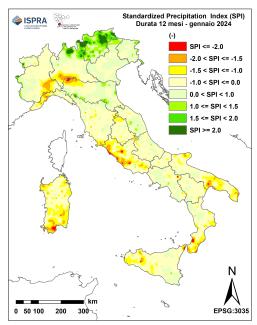
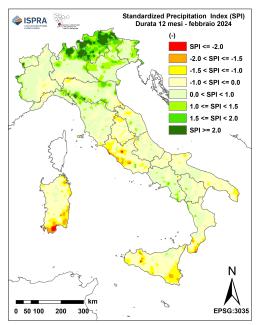
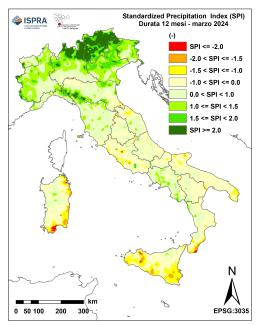
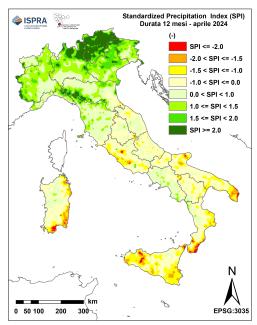
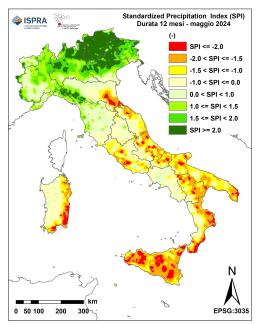

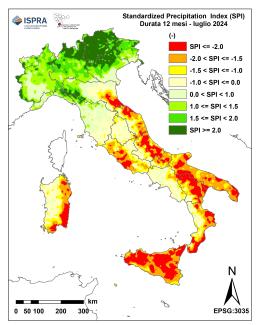
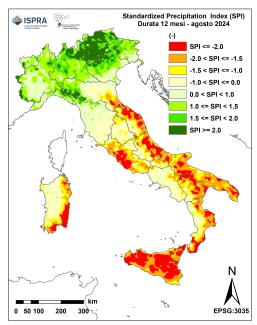
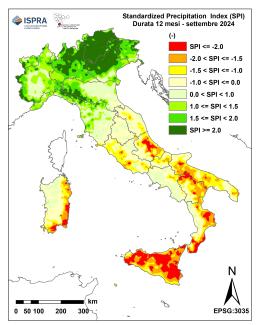
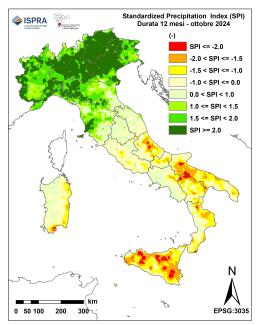
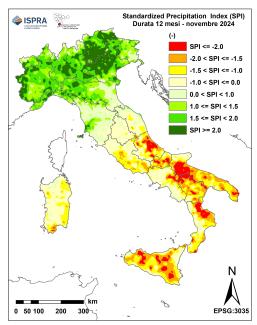
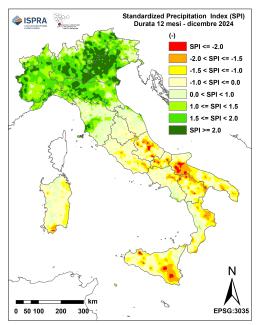

In 2024, the maps of SPI at 12 months (SPI12), calculated on the spaced precipitation on the grid with a horizontal pitch of 1 km of the ISPRA BIGBANG, showed conditional of drought, from extreme to moderate, in several areas of Central Italy, the South and the major islands, while the North was affected by conditions of humidity, also from extreme to moderate (Figure 1–12). This situation was determined by the access of precipitation that involved northern Italy, while the remaining part of the national territory suffered a considerable precipitation deficit (see the indicator "Precipitations" present in the Environmental Theme "Water sources and Balance" of the Environmental Indicators Database). In some areas, this deficit began to be observed as early as the end of 2023.
On the 12-month aggregation scale, chosen here for the calculation of the SPI in order to better describe the effects of drought on river flow, reservoir capacity, and aquifer recharge (the so-called "hydrological drought"), starting from May 2024 (Figure 5), an increase is observed in the areas affected by extreme drought (SPI12 ≤ –2.0), and especially in those areas affected by moderate or severe drought (–2.0 < SPI12 ≤ –1.0). The peak of extreme drought (SPI12 ≤ –2.0) was recorded in the month of June (Figure 6), with 16.1% of the national territory subject to this condition (Figure 13). Sicily and Calabria were the most affected regions, along with various areas on the Adriatic side of the mainland, from Calabria to Tuscany, on the Tyrrhenian side of Lazio, and the eastern part of Sardinia. To the 16.1% of territory affected by extreme drought must be added a further 24.8% corresponding to areas of the country affected by moderate or severe drought (–2.0 < SPI12 ≤ –1.0). Following in terms of extreme drought are the months of July (14.2% of Italian territory) and August (12.6%). In these two months, moderate to severe drought remained around 26–27% (Figure 13). In terms of the percentage of territory affected by moderate to severe drought, the months of May (28.5%) and November (24.8%) are also worth noting.
In 2024, the average (of the twelve monthly values) of the percentage of territory characterized by SPI12 less than or equal to –1.0 (i.e., all drought classes) was higher than the corresponding long-term average value (see the indicator "Percentage of the Italian territory subject to precipitation deficit and surplus" available in the environmental theme "Water sources and balance" of the Environmental Indicators Database).
The precipitation deficit observed in Central Italy, the South, and the major islands, worsened by the high temperatures recorded during 2024 (+1.33 °C for the annual national average temperature compared to 1991–2020), led in these areas to a reduction in the natural availability of renewable water resources (see also the indicator "Internal flow" available in the environmental theme "Water sources and balance" of the Environmental Indicators Database), with consequent socio-economic and environmental impacts.
The drought and water severity conditions that in 2024 have afflicted the national territory in a diversified way have been continuously monitored and analyzed by the permanent district observatories for water uses, organ of each District Basin Authority (pursuant to Legislative Decree no. 39/2023). During the year, the Observatories of the river districts of Northern Italy (Eastern Alps, Po River and Northern Apennines) have seen a substantial normal situation confirm, that is, an uncritical scenario of water severity. On the other hand, the Observatories of the river districts of the Central Apennines, the South Apennines, Sardinia, and especially that of Sicily have recorded conditions of water severity from high to medium (https://www.isprambiente.gov.it/pre-meteo/idro/SeverIdrica.html/), with the need to adopt appropriate measures and governance actions due to the level of water severity. In some cases (Sicily, areas of Basilicata served by the water scheme of the Basento-Camastra, and some Calabrian territories of the provinces of Reggio Calabria, Crotone and Cosenza), it has come to the declaration of a state of emergency for serious water deficit by the Council of Ministers.
For a detailed evaluation of the drought 2024, also for time scales of less than 12 months, please refer to the consultation of the hydrological and / or drought bulletins issued monthly at regional level by the offices responsible for the hydro-meteorological monitoring (federates within the National Table for the Services of Operational Hydrology: https://www.isprambiente.gov.it/pre-meteo/idro.